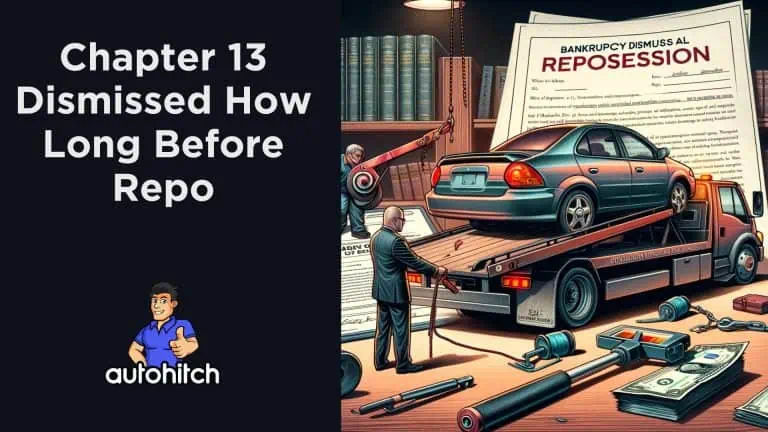If your Chapter 13 bankruptcy case gets dismissed, it can put your finances in jeopardy again. Most importantly, dismissal usually leads to the repossession of cars and other assets financed through loans.
When you file Chapter 13 bankruptcy, an automatic stay goes into effect that prevents repossessions and foreclosures.
But if your case gets dismissed, that protection goes away. Creditors can resume collection activities and repossess cars, homes, or other collateral if loan payments aren’t resumed.
So, understanding the consequences of dismissal and your options is critical to saving your assets. I created the article below to cover everything you need to know.
Relevant Articles To Read:
- Can I file For Bankruptcy And Keep My Car
- The Complete Guide to Car Repossession
- Car Repossession Laws By State
- What Happens If You Hide Your Car From Repossession
- What Time Do Repo Men Usually Come
Table of Contents
Consequences of Chapter 13 Bankruptcy Dismissal
The two major implications of having your Chapter 13 bankruptcy dismissed are:
- Loss of automatic stay protection
- Vehicle loans revert to original terms
Loss of Automatic Stay Protection
The automatic stay that begins when you originally filed for Chapter 13 is lifted if the case is dismissed. This opens the door for creditors to restart:
- Collection phone calls
- Wage garnishments
- Lawsuits
- Home foreclosures
- Vehicle repossessions
Most concerning for many filers is the risk of car repossession returning after Chapter 13 dismissal. This threat comes from vehicle loans immediately reverting back to their pre-bankruptcy terms.
Vehicle Loans Revert to Original Terms
In Chapter 13 bankruptcy, vehicle loans can get certain benefits, like lowered monthly payments.
But if the Chapter 13 case ends up dismissed, any changes made to vehicle loans are reversed. This means:
- The original loan balance owed returns
- The original higher interest rates go back into effect
- Any lowered loan payments under Chapter 13 no longer apply
With the improved terms nullified, outstanding monthly payments that weren’t made during the bankruptcy quickly pile up.
This suddenly puts the loan into delinquency since payments were skipped or smaller under Chapter 13. Facing large arrearages, the repo man may soon come knocking.
Getting Your Vehicle Back After Chapter 13 Dismissal
If your car is repossessed because you couldn’t keep up with payments after Chapter 13 dismissal, is there any way to get it back?
Maybe. But your options are limited, and you have to act very quickly. Potential ways to recover your repossessed vehicle include:
- Reinstate the loan terms: If you can pay the total arrearage and repossession fees owed soon after the repo, the lender may give back the car. But you must be able to resume ongoing payments.
- Refile bankruptcy: Filing Chapter 13 or Chapter 7 bankruptcy again could stop a repossession and give you time to become current on payments.
- Convert to Chapter 7: Switching from a dismissed Chapter 13 to liquidation under Chapter 7 keeps certain loan cramdowns intact as long as you settle any outstanding balances.
However, these options have limited timeframes and strict requirements. The sooner you take action after a repo, the better your chances of success.
What Are Your Options Once Chapter 13 Is Dismissed?
While dealing with your urgent vehicle loan and potential repossession issues are the top priority following dismissal, you also need to develop a longer-term plan to stabilize your broader finances.
Here are options for getting back on track when Chapter 13 doesn’t work out:
Refile Your Chapter 13 Case
If the court didn’t dismiss your case “with prejudice”, meaning permanently, you may be able to refile Chapter 13 relatively quickly. This resets the automatic stay protection.
But you have to correct whatever issue triggered the first dismissal—typically missed payments, incomplete forms, or failure to provide documentation to your trustee. Otherwise, your new Chapter 13 case could get dismissed again.
Shift Your Bankruptcy to Chapter 7
You may decide to change course and file for Chapter 7 liquidation instead. While this discharges many debts, some assets must be sold off by a trustee to pay creditors.
The means test determines Chapter 7 eligibility. If your average gross monthly income over the past six months is below your state’s median, you likely qualify.
One upside to converting from Chapter 13 to Chapter 7 is keeping certain benefits from your initial filing, like vehicle loan cram downs that reduced balances owed.
Modify Your Chapter 13 Repayment Plan
If your financial situation changes during your bankruptcy, causing you to default on required payments, ask if you can modify the repayment plan.
While not guaranteed, courts may allow adjustments like reduced monthly amounts or extended repayment terms if the cause is involuntary job loss, medical problems, or something similar out of your control.
Voluntary Dismiss Your Chapter 13 Case
Believe it or not, there are rare situations where you might want to voluntarily dismiss your own Chapter 13 case if doing so helps resolve debts.
For example, if you are surrendering property to satisfy debts anyway, dismissal speeds this process versus staying in ongoing bankruptcy.
Key Takeaways
- Get clarity on why your specific Chapter 13 case was dismissed in the first place
- Be prepared to act very quickly to avoid repossession of vehicles or other financed assets
- Consider refiling bankruptcy or shifting your approach from Chapter 13 to Chapter 7
- Seek ways to modify the original repayment plan if possible before dismissal
Understanding why your Chapter 13 was dismissed and your options after helps limit further financial damage while regaining control. Reach out to an attorney for legal assistance if you’re facing complications.
Sources For This Article
- https://upsolve.org/learn/what-happens-when-a-chapter-13-case-is-dismissed/
- https://answers.justia.com/question/2023/01/23/if-my-chapter-13-case-was-dismissed-toda-943703
- https://ask-a-lawyer.lawyers.com/bankruptcy/what-can-i-do-if-my-chapter-13-was-dismissed-and-attempts-are-being-made-to-repossessed-my-car-despite-me-making-payments-1550946.html
- https://www.quora.com/What-happens-after-a-car-is-repossessed-and-the-person-filing-for-bankruptcy-but-can-t-afford-to-pay-for-it-What-are-the-consequences-How-long-does-this-last



